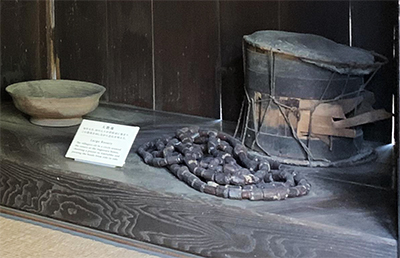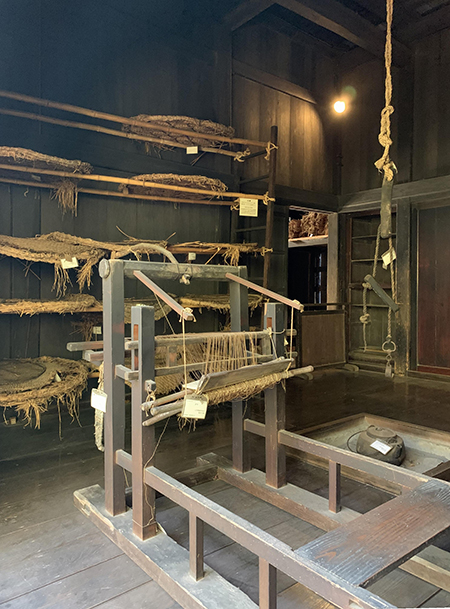

日本人はいつ頃からいまのように「無宗教」が多数派になってきたのか。
古民家を見ていると、すべからく最上級のしつらいの空間とは、
先祖崇拝と神仏への帰依が基本的な構成要素になっていることがあきらか。
この出羽三山麓の菅原家住宅でも、カミデイは唯一の畳敷の部屋で、
現代で言えば村長にも相当する肝煎〜きもいり〜の家柄ということで、
村の人々がここに集まって、大きな数珠をみんなで繰回しながら念仏を唱える、
いわゆる百万遍念仏を行ったという。
これは複数の人間が同時同音で念仏を唱えることによって互いの念仏の功徳を
融通しあうことが出来るとする考えに基づいている。
念仏を唱えることが功徳でありその回数を集団的に実現させるという習俗。

床の間に飾られている数珠を何人も手渡ししながら行っていたとされる。
こういう風習が根付いた当初には特定の仏教的な考え方がある。
百万遍念仏と極楽往生を結びつけた最初の人物は唐の迦才(『浄土論』)。
日本には平安時代に伝来し「浄土教」流行とともに盛んになった。
鎮護国家思想以来、宗教に深く関わる朝廷がこの様式を認証したことで、
室町から戦国にかけて地方の村々の間にまで百万遍念仏が広まったとされる。
そういういわば公的性格を帯びた行事がこの地域でも伝統として保守されてきた。
床の間の隣りに「アミダサマ」が設けられるのもこの家の特色だという。

これはあきらかに阿弥陀如来。「浄土教」においては阿弥陀如来一仏を本尊とする。
浄土教諸宗において主に用いられる『仏説無量寿経』では、
「無量寿仏の威神光明、最尊第一にして、諸仏の光明及ぶこと能わざるところなり」。
北陸地方は本願寺勢力の根拠地とされるが、環日本海地域北辺として、
出羽三山地域も同様の文化圏にあったと理解するべきなのだろう。
・・・新聞、テレビなどの情報化社会の進展でこうした宗教文化風習は淘汰されていく。
静かな、内省的な時間が家庭から奪われて騒々しい情報の雑音に取り囲まれ
その時間が宛てられていたと思われる「祈りの時間」が消え去った・・・。

そして家の女性たちが奏でていた機織りのリズム感も遠く消え去っていった。
ラジオやテレビが家庭に入り込む以前の暮らしには、
規則的なリズム感、音楽性とは機織りのそれしかなかったのではないか。
いまにして思うと、情報が家庭になだれ込んできた一方、
大切ななにかが失われたとも感じる。
English version⬇
[Loss of prayer and weaving from the house / Good Japanese house ㉓-5]
When did the Japanese become the majority of "non-religious" as they are now?
Looking at an old folk house, what is the most difficult space in all?
It is clear that ancestor worship and devotion to the gods and Buddha are the basic components.
Even in the Sugawara family's house at the foot of Mt. Dewa, Kamiday is the only room with tatami mats.
In modern times, it is a family of liver roast that is equivalent to the village mayor.
Villagers gather here to sing Nembutsu while repeating large beads together.
It is said that the so-called Million Honorable Buddha was performed.
This is the merit of each other's Nembutsu by chanting Nembutsu with the same sound at the same time by multiple people.
It is based on the idea that we can be flexible.
It is a merit to recite the Nembutsu, and it is a custom to collectively realize the number of times.
It is said that many people handed over the beads displayed between the floors.
When these customs took root, there was a particular Buddhist way of thinking.
The first person to connect the million Buddha and paradise was the Tang dynasty ("Jodo theory").
It was introduced to Japan during the Heian period and became popular with the "Pure Land Buddhism" epidemic.
Since the imperial court, which has been deeply involved in religion since the idea of the chingo kokka, has certified this style,
It is said that a million Buddhas spread from Muromachi to the Warring States period among the local villages.
Events with such a public character have been maintained as a tradition in this area as well.
It is said that the characteristic of this house is that "Amidasama" is installed next to the alcove.
This is obviously Amida Nyorai. In "Pure Land Buddhism", Amida Nyorai Ichibutsu is the principal image.
In the "Buddhist Theory Mugenjukei", which is mainly used in the Pure Land Buddhist denominations,
"The prestige of the Buddha of Infinite Life, the most precious first, is the place where the light of the Buddhas cannot reach."
The Hokuriku region is considered to be the base of the Honganji forces, but as the northern part of the Pan-Japan Sea region,
It should be understood that the Dewasanzan area was also in a similar cultural area.
... Such religious and cultural customs are being eliminated with the development of information-oriented societies such as newspapers and television.
Quiet, introspective time is taken away from home and surrounded by noisy information noise
The "prayer time" that seems to have been addressed to that time has disappeared ...
And the rhythmic feeling of weaving played by the women in the house has disappeared.
For life before radio and television entered the home,
Perhaps the only regular sense of rhythm and musicality was that of weaving.
When I think about it now, while information has flowed into my home,
I also feel that something important has been lost.



















